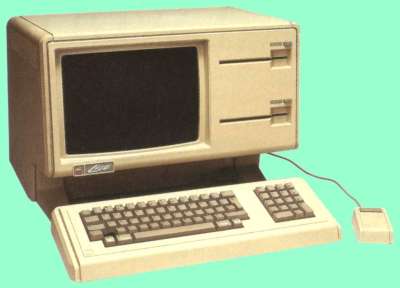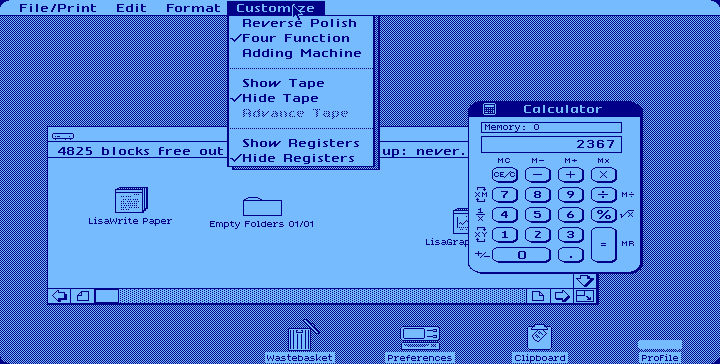
|
Manufacturer |
Apple Computers (US) |
Model |
Lisa
(Officially for Local Integrated Software Architecture, but also the name of Steve Jobs's daughter.) |
Date Launched |
January 1983
Did not ship to customers until June 1983. |
Price |
Approx £8500 with the 5 megabyte Profile hard disk drive.
($9995 in the US) |
Microprocessor type |
Motorola 68000 @ 5 MHz |
ROM size |
64 kilobytes containing system diagnostics. |
Standard RAM |
512 kilobytes or 1 megabyte
An extra 512 KB of RAM cost $1495. |
Maximum RAM |
2 megabytes |
Keyboard type |
Separate keyboard with numeric pad |
Supplied language |
None. BASIC ($395), Pascal ($595) and CoBOL ($795) were available.
The operating system was Lisa Office System and featured cooperative multitasking and virtual memory. |
Text resolution |
Variable depending on software |
Graphics resolution |
720 x 364 pixels |
Colours available |
Monochrome (blue) |
Example Screenshot |

A simulation of the Lisa desktop, created by Marcin Wichary. This will look familiar to anyone who has used GEM on the Atari ST, which was partly cloned from the Lisa/Macintosh interface.
|
Sound |
Not known |
Cassette load speed |
The Lisa I (shown) was fitted with two 5¼ inch floppy disk drives holding 860KB each.
This high capacity was obtained by spinning the disks slower for tracks nearer the outer edge, so that the number of bits stored per unit length of track was kept constant.
The disk format and operating system had been carefully designed to minimise the chance of data loss, e.g. disks could not be removed until all open files had been closed. In practice however the drives proved troublesome and also needed non-standard disks, with the read slots on the two sides offset. Blank disks cost around $12 each.
The Lisa II from January 1984 utilised a more reliable single 400 kilobyte 3½ inch floppy drive and an internal 10 megabyte hard disk. |
Dimensions (mm)
Weight (grams) |
Approx. 500 x 400 x 350 (main box)
About 22000 |
Special features |
The Lisa was the first commercially available desktop computer with a graphical user interface (i.e. using a mouse and menus.)
Contained seven integrated application programs:- LisaCalc - spreadsheet
- LisaDraw - graphics/drawing package
- LisaWrite - word processor
- LisaGraph - for producing graphs and charts from LisaCalc data
- LisaProject - project management/scheduling
- LisaList - simple database
- LisaTerminal - terminal emulation for accessing remote computers.
A 12 inch monitor was built into the main unit. |
Good points |
The applications ('tools') were easy to use together on a single document.
Error messages took the form of dialogue boxes with clear explanations and option buttons.
Graphics resolution was high for the time, giving a clear text display.
The Lisa was easy to dismantle and service. |
Bad points |
The price of the Lisa was far too high for most businesses to consider it.
The hard disk drive had to sit untidily on top of the monitor since there was no spare room inside the case.
A 5 MHz processor was not really fast enough for the demands of the graphical interface and the Lisa was sluggish to use.
Little software other than the seven standard applications was available. |
How successful? |
Despite its advanced features the Lisa did not sell particularly well.
The Apple Macintosh, which had been developed in parallel with the Lisa and was launched the following year, was more versatile and substantially cheaper than the Lisa, and Apple concentrated on the more commercial 'Mac'.
The Lisa was discontinued in April 1985 after around 100,000 had been sold. |
Comments |
Apple spent three years and $50 million developing the Lisa.
The design of the Lisa owed much to the Alto computer built by Xerox PARC. This had 128 kilobytes of RAM, a graphical interface, a mouse and the ability to be networked to other computers. The Alto was built in 1975 but Xerox never marketed it and thus missed out on being the leaders by several years in graphical operating systems. (A derivative of the Alto, the Xerox Star 8010, was sold in 1981, but at $16,595 it had minimal sales.)
Bearing in mind that the Lisa came with all the hardware and software needed to use it fully straight away, it was perhaps not quite as outrageously expensive as it first seemed.
Although the Lisa itself was not a huge success, without the Lisa there might not have been a Macintosh or WindowsTM. |

